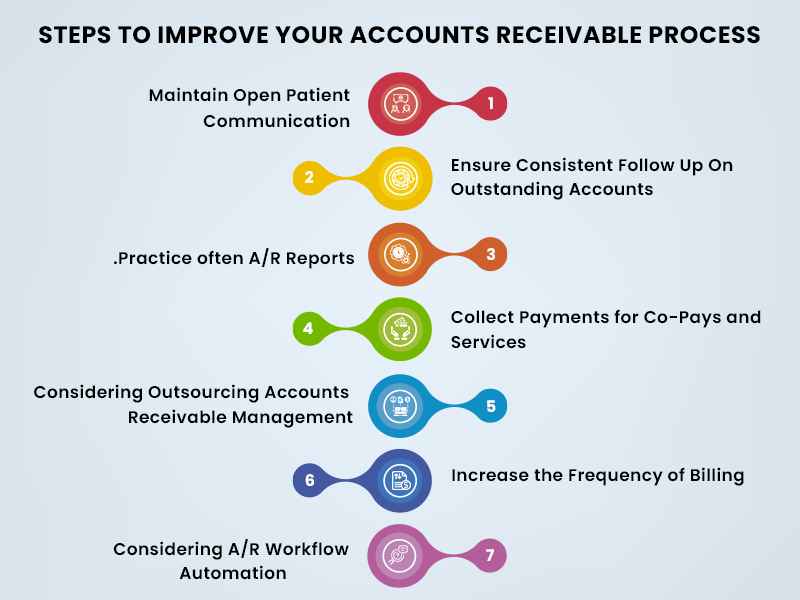Receivable Management in healthcare refers to the process of effectively managing and collecting outstanding payments from patients, insurance companies, and other third-party payers for healthcare services rendered. It involves monitoring, tracking, and optimizing the collection of Accounts Receivable to ensure timely and accurate reimbursement for healthcare providers.
In the healthcare industry, Account Receivable Management is crucial for maintaining financial stability and cash flow for healthcare organizations, including hospitals, clinics, medical practices, and other healthcare facilities. Effective Accounts Receivable Management helps healthcare providers maximize revenue, minimize bad debt, and improve overall financial performance.
Many practices have been compelled to focus more on their Accounts Receivable administration as a result of the increased popularity of high-deductible insurance policies. Moreover, paying for the best care is often expected from patients. These adjustments necessitate renewed focus and creativity in the practice’s billing and collection processes.
To Improve Your Cash Flow
The cost of interest and inflation is the unrecognized expenses related to an Account Receivable balance. Since these expenditures aren’t actual expenses that you incur, they won’t appear on your income statement. However, it’s crucial to acknowledge that these expenses do, in fact, exist.
The salaries you pay your employees to mail statements and call patients for follow-up are administrative costs related to managing Accounts Receivable. Postage costs and any other supplemental costs paid when handling AR are also included. On your monthly financial statements, you can see these actual expenses.
Your overall balance will rise along with the administrative charges associated with managing your AR. You wind up spending more money on postage to resend billing statements, and time for your personnel to contact delinquent patients when payments aren’t collected the first time.
Pay particular attention to the insurance company receivables that are due. Follow up with the carriers if balances are 30 to 45 days old. Basically, insurance firms must pay claims within 45 days of receiving a “clean claim”.
Insurance companies are eager to deny claims for a variety of reasons, despite having a duty to pay. Just a few examples include incorrect coding, missing information, and invalid insurance.
1. Maintain Open Patient Communication
Providers with clear payment terms are less likely to experience delays with AR. Ensuring the patient is aware of the payment expectations before any services are provided can help reduce the incidence of late or unpaid invoices in many cases. A written statement of financial responsibility that new patients sign at their first session provides a clear understanding of what is anticipated in terms of payments.
2. Ensure Consistent Follow Up On Outstanding Accounts
With medical receivables, late payments are given. However, unpaid, open accounts must be properly managed. A total of 93 percent of businesses deal with late payments, and 1.5% of all businesses have bad debt written off. The longer unpaid accounts go unpaid, the less probable it is that they will be reimbursed. Ensure that patients are informed frequently via phone calls and letters, and where required, pursue more aggressive collection methods.
3. Practice often A/R Reports
4. Collect Payments for Co-Pays and Services
Patients paying co-pays or bills in-office help medical practices reduce their Accounts Receivable. For some operations or treatments, some offices even demand upfront deposits or percentage payments rather than waiting until after the procedure or treatment to ask for payment in full. This approach might not reduce the total number of accounts, but it might reduce the amount of money owed. The revenue received in advance helps the provider’s financial flow.
5. Considering Outsourcing Accounts Receivable Management
6. Increase the Frequency of Billing
The faster payers are invoiced for services, the faster those unpaid accounts can be settled. The fact that many providers only deliver bills once a month, however, might cause delays with Accounts Receivable. It doesn’t harm to think about raising the frequency of billing to speed up operations. For instance, you may mail or submit insurance or patient invoices every week.
7. Considering A/R Workflow Automation
Automating the A/R workflow saves time by caring for some of the more demanding A/R-related chores. Numerous programs increase the possibility of automated A/R. An illustration. Benefits verifications, making claims, and producing A/R reports are all handled by Revenue Cycle Management (RCM) solutions.
Invoicing and payment collection become prompter thanks to this kind of automation, which also lessens issues with forgotten A/R accounts or claims denials.







